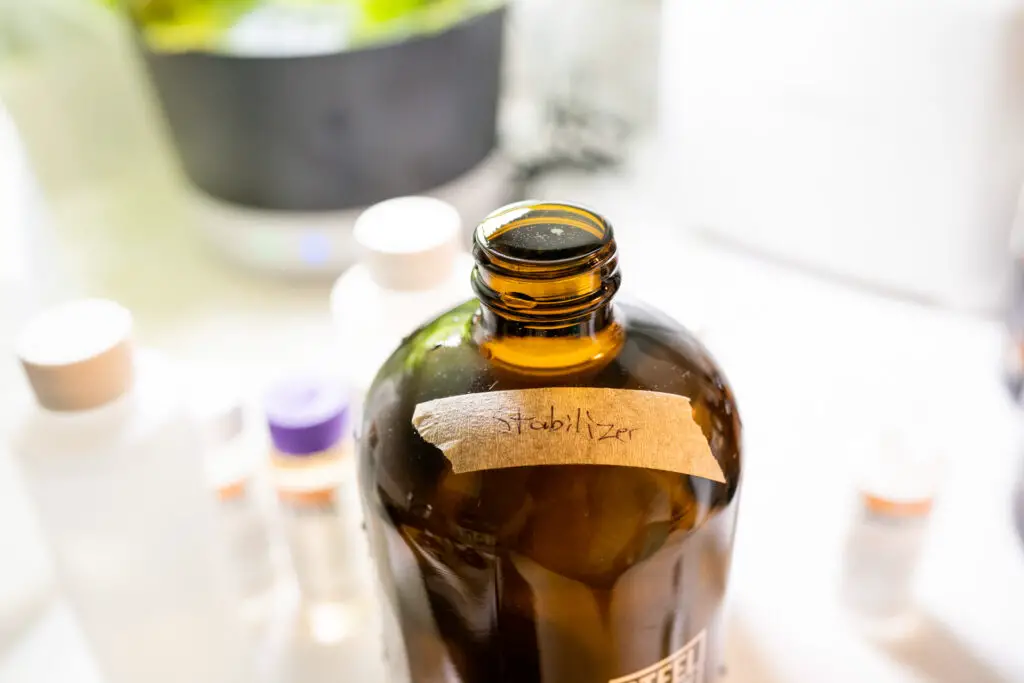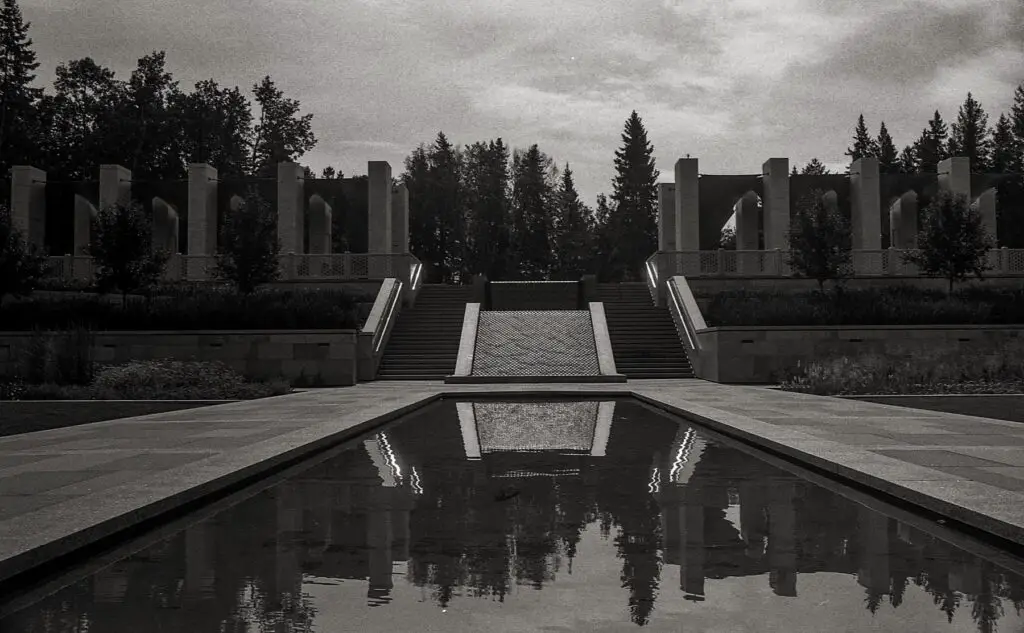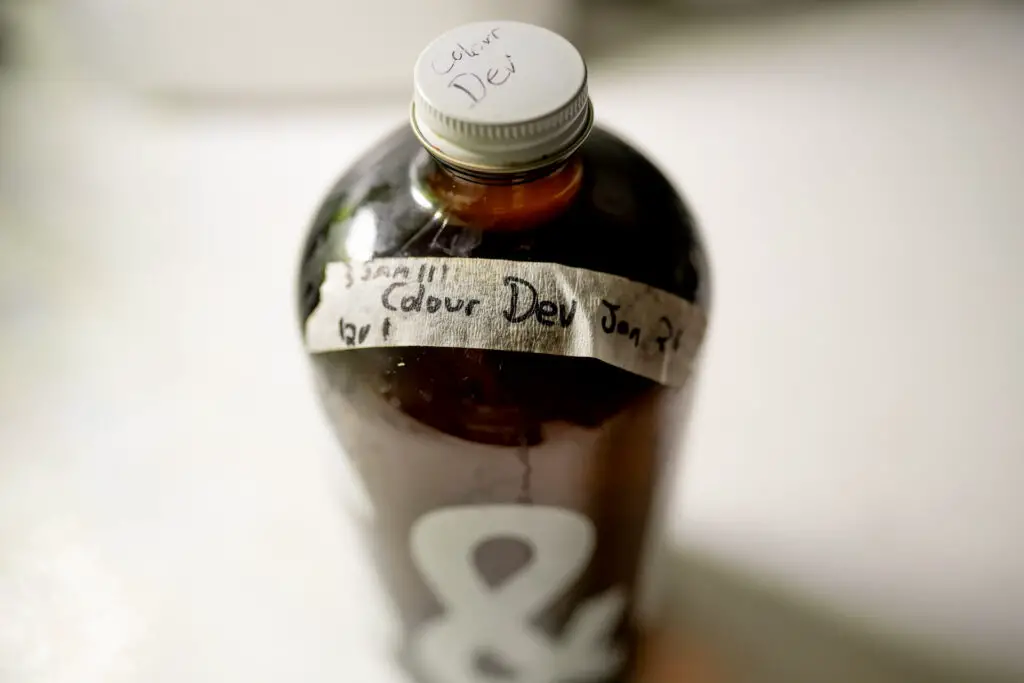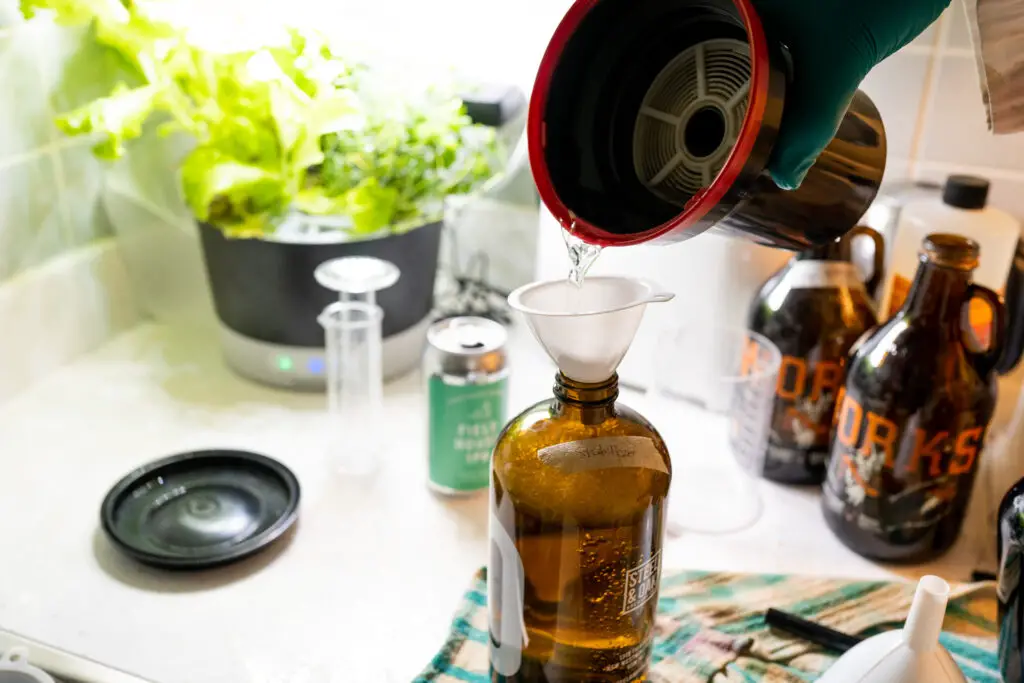Darkroom Photography Do You Put Reused Fixer Back Into Fresh Fixer?

When you're first getting into developing film and making prints, you might not be reaching for the chemicals all that often. Most photographers take much fewer photographs in the winter, then information technology could even take an unabridged 6 months earlier y'all're yearning to get back to developing film. And information technology's e'er possible to end up going through a lull at one betoken or another. And the worst thing to come up dorsum to is a pile of useless, expensive, environmentally dissentious chemicals.
Only why do these chemicals spoil? Our homes are filled with hundreds of chemicals that don't expire over time, so what makes these different?
Motion picture developing chemicals are typically difficult to store for two primary reasons: developer and logroller are both reducing agents, meaning they react with oxygen. This ways to make them store over a long menstruum of time, the solutions accept to be stored in ways that limit their exposure to air.
I'm lucky enough to have spent some of my post-secondary education in a chemistry lab. So I've learned a variety of ways to proceed chemicals lasting as long equally possible — both with and without fancy lab tech. It's catchy at outset, simply it doesn't accept to exist expensive.

How do I brand chemicals last longer?
Moving-picture show developing chemicals volition last their longest when mixed with distilled h2o, and stored without any pockets of air in the bottles. They should be stored in cool weather condition away from sunlight.
When yous're mixing chemicals, tap water will contain different contaminants depending where in the earth you lot live. Because of this, the movie developing chemicals volition well-nigh always concluding longer using distilled water, which is completely free of any minerals. That said, In almost cases, tap h2o won't seriously dethrone the chemicals over the short term.
If you plan to use the developer or fixer within a calendar month of two, tap water won't be much of an issue so long as the bottles are air tight. Be certain to use cold tap h2o, as hot or warm water may contain more than contaminants built upward over time inside the hot water heater. Not just does the hot h2o bear upon the chemicals, it tin can too leave spots on your picture show when it dries.
For printers using large trays, it is also possible to re-use the chemicals over time. Notwithstanding, dust and other particles often find their way into the chemicals. The best solution I've found is to filter them out using bleach-gratis cone-shaped coffee filters. The cone shape fits perfectly into a funnel for easy pouring, and the unbleached versions ensure that no left-over bleach leaches into the solution.

What's the best container to store film development chemicals?
I've used a number of dissimilar solutions for storing moving-picture show chemicals, from plastic bottles designed for it, to simple and ordinarily available beer growlers.
Almost every store that sells film chemicals will accept some plastic bottles designed for storing chemicals. They'll range from dark-brown regular plastic bottles with a white-board style sticker on them for labeling, to large bottles that accept accordion shapes on the side to compress the air out of the bottles. Because oxygen is the enemy of moving picture developing chemicals, the piano accordion-way bottles are a really good option for large 5-Litre (1 gallon) batches of chemicals that are typical with powdered chemicals. Specially if y'all find ane that has a expert seal and a handle, it'll keep the chemicals fresh for much longer than a standard plastic bottle.
But even these plastic bottles do have a large flaw. If the seals don't break over fourth dimension, oxygen will slowly seep through the plastic and ruin the chemicals. It's a slow process, but it is noticeable. For example, this is the reason why a bottle of Ilford Rapid Fixer must be used inside two years of production — even if the bottle is completely sealed. This is especially truthful if there's fifty-fifty a fiddling pocket of air on the elevation of the accordion bottle. That pocket tin can slowly allow air through, and you'll come back a week or ii afterwards to see the canteen is no longer compressed.
Because of that, I've had the all-time luck with glass bottles filled completely to the brim. I personally employ growler bottles because they're available and come with fresh local beer. These bottles seal extremely well when completely filled, and the dissimilar designs aid me to differentiate the chemicals when developing.
You'll know you have the canteen perfectly full when at that place's a bit of water over top of the rim of the canteen. If a bead of water doesn't come down the side when you spiral on the cap, add a bit of distilled h2o to the mix until it does. Using this method, I've had a diluted logroller solution final longer than the undiluted solution in the plastic bottle.

Do Liquid or Pulverisation developers terminal longer?
Because oxygen can seep through plastic bottles, liquid solutions are not completely prophylactic. Even if the bottle is still sealed, it tin can become oxidized over time. Powdered developers don't take this problem. The reducing agents in the developer are inert until they're dissolved in water. Significant a bag of powdered D-76 from the 1930s should theoretically even so make a viable developer. Assuming it was stored dry for its 100-year journey into your fateful darkroom.
But one time these chemicals are mixed, they accept a much shorter shelf-life than their liquid compatriots. Assuming the mixing is completed perfectly without contamination and at the exact right temperature, information technology will last just as long. But the truth is, that rarely happens. Mixing dry developing chemicals is difficult. Put the powder in water at depression temperatures, and it'll for photograph-ruining clumps like no-name brand mac and cheese.
The all-time choice is to boil distilled h2o to the right temperature and promise there aren't contaminants built upwards in your kettle, or use a Sous Vide to heat the water to the exact required temperature in the technical data sheet.
Once a bottle of liquid programmer or fixer is opened, it tends to have a longer shelf-life than the powdered versions. That's because the labs where these chemicals are mixed are designed upward to the highest contamination-complimentary standards. Their chemicals need to get to their customers' easily and nonetheless exist functional. So they take great pains to reduce any form of contamination in their facilities.
That said, some developers like Rodinal (Blazinol in Canada) are unlikely to always go bad because of their stable chemical formulas. It's a common developer's joke that rodinal volition outlive the shelf information technology's stored on. This used to exist the same for the syrupy-formula for Kodak HC-110. Simply the new formulation seems to go back much more quickly, unfortunately.
Personally, I always utilise liquid film development chemicals because of their ease of use. They're much quicker and more dependable than powdered forms. And so I'll continue to use them every bit long as possible. Learn more than almost the differences between liquid and powdered developers here.

Can I reuse mixed black and white moving picture programmer?
Aye, developer can exist reused once or twice subsequently information technology has been mixed. The number of times that it can be reused changes significantly depending on the type of developer. So its best to bank check the Technical Data Sheets online to make sure that you're using the chemicals within their tolerance.
When reusing developers, information technology's best to add additional time to ensure the film develops properly. For case, The Ilford technical data sail for DD-X suggests calculation an additional x% onto the developing time with each additional roll. Take, for example, using DD-Ten to develop a coil of Delta 3200 at box speed. The start roll requires 9.5 minutes of developing time. So, for the second roll, you lot'll add together x%, and develop for x.45 minutes, or 10 minutes and 27 seconds.
Each developer will have a different amount of time per additional roll. Color programmer, for example, recommends calculation 8% additional time for every canvass of 120, or ii rolls of 35mm film. Always check the technical datasheet for more information. And if yous're going to reuse it, make sure to handle this chemical carefully. Particularly if you have eczema, a set of nitrile gloves and a lab coat will go a long way to keeping your peel good for you in the long run.
With that in mind, B&W film developers should not be stored after they have been mixed. Even if they're mixed with distilled water (which isn't necessary), they are still likely to become bad overnight. Water contains oxygen, which will oxidize the diluted developers more quickly than not-diluted forms. So it's all-time to re-employ the developer within a single session if possible, or dispose of information technology in accordance with local laws.
How many times can I reuse my Stop Bathroom?
Cease bath is the easiest solution to reuse. I've had the same bottle going strong for well-nigh a year now with a couple of minor meridian-ups over time. This is considering the stop bathroom is purely an acid meant to remove the conditions where the developer can continue to human action on the moving picture (and ruin the fixer).
Stop bath is basically super-concentrated vinegar with an indicator. Once information technology loses its acidity, the indicator will brand the solution instantly turn a deep purple. This means you can proceed re-using the developer until it changes colour. Even if it's mixed, it doesn't react with oxygen, and doesn't need any special care. The sad thing is it'due south too the cheapest chemical of the bunch — if only DD-10 had that economic system, I would be a very happy movie programmer.

How ofttimes tin I reuse Fixer?
Logroller is designed to exist reused over time. A litre of Ilford Rapid logroller tin set 24 rolls of picture show without being replenished according to Ilford's Technical Data Canvass. Beyond that, the fixer may not fix the film to archival standards, meaning the rolls might fog over time equally some of the leftover silver reacts to light.
To furnish the fixer, simply add 45ml of fresh rapid fixer solution per roll of processed picture show. While the bottles of stock solutions merely terminal vi months after opening, a solution of logroller tin last almost indefinitely if stored correctly with proper replenishment. Over time, though, the fixer volition collect a large amount of silver in the solution, which volition make it unusable. Silver is as well an environmental hazard. And so it'southward recommended bringing spent fixer solution to a facility that can dispose of it properly. In most cases, you'll have to bring it to your local waste-disposable heart. But quite oftentimes, photograph labs volition take the chemicals back gratis of charge.
Larn more almost using fixer in this article, where I go over everything, from how long information technology lasts, to the best kinds of logroller to employ.

By Daren
Daren is a journalist and wedding photographer based in Vancouver, B.C. He's been taking personal and professional photos on film since 2017 and began developing and printing his own photos after wanting more than control than what local labs could offer.
0 Response to "Darkroom Photography Do You Put Reused Fixer Back Into Fresh Fixer?"
Post a Comment